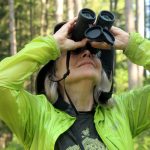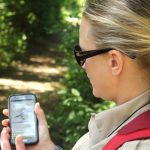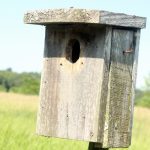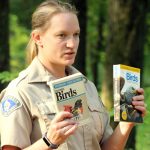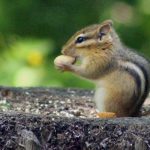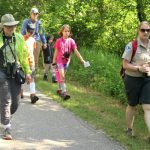Hikers go birding at Hartman Creek
By Greg Seubert
What does a red-eyed vireo have in common with a yellow-rumped warbler?
They’re two of more than 120 species of birds that have been spotted in Hartman Creek State Park.
The 1,500-acre park, located about seven miles west of Waupaca on the Waupaca/Portage County line, is popular for its campground, swimming beach and trail system for mountain bikes, horses and cross-country skis.
It’s also a great place to go bird watching.
Lisa Bey, the park’s new naturalist, led eight people on a two-hour bird-watching hike June 29 that included stops in a pine plantation and prairie.
“I just want people that maybe have never tried birding before and get them out there,” she said before the hikers gathered at the Hellestad House in the Allen Lake Picnic Area. “I know a lot of people are reluctant because, ‘Oh, I don’t know what that bird is.’ I want to get them comfortable and let them know what resources they have available to them.”
Mary Faucher of New London showed up for the hike. She and her husband have brought their horses to ride on the park’s equestrian trails several times, but not on this day.
“This is my first time bird watching,” she said. “I have a few birds around my house. I love the red cardinals. They’re beautiful. I like to walk a lot, so I’m looking to learn some more information.”
Before heading out on the hike, Bey offered a few tips on what birders should carry with them.
“A guidebook to me is the No. 1 key,” she said. “Binoculars are helpful. A camera is good because I can’t always get birds to sit still long enough to identify them. If you snap a picture, you can go back later.”
Temperatures hovered near 80 degrees as the hike began at 8:30 a.m. from the Hellestad House.
Bey wasn’t sure how many birds the group would see.
“It is pretty hot out today, so I don’t know if we’re going to see as many birds as we would on a day that’s 20 degrees cooler,” she said. “However, all of the fledglings are out and about, so we might get lucky. They’re learning to fly and they still need to eat quite a bit at that age, so we might still see quite a bit of activity.”
It didn’t take long before the group found a common grackle, a member of the blackbird family, high in a tree near Allen Lake.
From there, it was off to the pine plantation, where hikers used their binoculars to get a close-up view of a downy woodpecker, one of seven woodpecker species that have been documented in the park.
The hikers then headed to a large prairie area that includes several Eastern bluebird nest houses. Volunteers built and monitor the houses for the bluebirds, which were in decline in Wisconsin and other states due to loss of habitat and nesting sites.
The prairie is an ideal spot to see turkey vultures soaring above the ground in search of food, Bey said.
From there, the group headed to the campground, where hikers saw an oriole nest at one campsite and bluejays at another.
There’s more to bird watching than just seeing birds, according to Bey.
“I want to talk a lot about the mental health and physical health benefits of bird watching,” she said. “The obvious is getting outside and walking. There was an interesting study conducted by two universities in Britain and Australia that proved that even being able to see green spaces and birds and nature could actually reduce the amount of stress, anxiety and even depression by up to 20 percent. For older people and those dealing with dementia or anything like that, it helps keeps your mind sharp. You have to identify the birds. It has a lot of mental health benefits that people don’t think about.”

